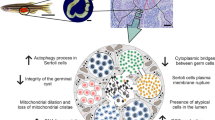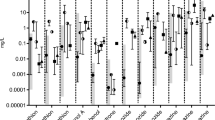Abstract
Difenoconazole (DFZ) is a widely used triazole fungicide which has been detected in some estuaries and embayments. This study was conducted to investigate the effects of DFZ on ovarian development in female marine medaka (Oryzias melastigma). After 180 days exposure of the embryo to DFZ (0, 1, 10, 100 and 1000 ng/L), the gonadosomatic index and percentage of mature oocytes produced were significantly reduced in the 1, 10 and 100 ng/L treatments but not the 1000 ng/L treatment compared to the control, thus exhibiting a U-shaped dose response curve. The relative mRNA levels of brain follicle-stimulating hormone, ovarian cytochrome P450 aromatase (CYP19s), hepatic estrogen receptors and vitellogenin, and the ratio of 17β-estradiol to testosterone in the muscle, also showed a U-shaped dose response, which was consistent with the development of oocytes. In addition, glutathione S-transferase activity in the ovary showed a U-shaped dose-response. These results gave an explanation for this U-shaped dose-response. The egg number produced, the hatch ability and the swim-up success in the F1 generation all showed a U-shaped dose response, indicating that exposure to DFZ at low concentrations can cause a decrease of fecundity and viability of the next generation. Thus, a more extensive evaluation of the impact of DFZ on marine fish reproduction at realistic environmental concentrations is needed.






Similar content being viewed by others
References
Amano M, Urano A, Aida K (1997) Distribution and function of gonadotropin releasing hormone (GnRH) in the teleost brain. Zool Sci 14:1–14
Ando H, Urano A (2005) Molecular regulation of gonadotropin secretion by gonadotropin-releasing hormone in salmonid fishes. Zool Sci 22:379–389
Ankley GT, Jensen KM, Kahl MD, Makynen EA, Blake LS, Greene KJ, Johnson RD, Villeneuve DL (2007) Ketoconazole in the fathead minnow (Pimephales promelas): reproductive toxicity and biological compensation. Environ Toxicol Chem 26(6):1214–1223
Calabrese EJ (2004) Hormesis: from marginalization to mainstream. A case for hormesis as the default dose–response model in risk assessment. Toxicol Appl Pharmacol 197:125–136
Calabrese EJ (2005) Toxicological awakenings: the rebirth of hormesis as a central pillar of toxicology. Toxicol Appl Pharm 204:1–8
Calabrese EJ (2010) Hormesis is central to toxicology, pharmacology and risk assessment. Hum Exp Toxicol 29:249–261
Canosa LF, Stacey N, Peter RE (2008) Changes in brain mRNA levels of gonadotropin-releasing hormone, pituitary adenylate cyclase activating polypeptide, and somatostatin during ovulatory luteinizing hormone and growth hormone surges in goldfish. Am J Physiol Regul Integr Comp Physiol 295:1815–1821
Chu SH, Liao PH, Chen PJ (2016) Developmental exposures to an azole fungicide triadimenol at environmentally relevant concentrations cause reproductive dysfunction in females of medaka fish. Chemosphere 152:181–189
Fasulo S, Marino S, Mauceri A, Maisano M, Giannetto A, D’Agata A, Parrino V, Minutoli R, DeDomenico E (2010) A multibiomarker approach in Coris julis living in a natural environment. Ecotoxicol Environ Saf 73:1565–1573
Goetz AK, Ren HZ, Schmid JE, Blystone CR, Thillainadarajah I, Best DS, Nichols HP, Strader LF, Wolf DC, Narotsky MG, Rockett JC, Dix DJ (2007) Disruption of testosterone homeostasis as a mode of action for the reproductive toxicity of triazole fungicides in the female rat. Toxicol Sci 95(1):227–239
Goetz AK, Rockett JC, Ren H, Thillainadarajah I, Dix DJ (2009) Inhibition of rat and human steroidogenesis by triazole antifungals. Syst Biol Reprod Med 55(5–6):214–226
Habig WH, Pabst MJ, Jakoby WB (1974) Glutathione S-transferases the first enzymatic step in mercapturic acid formation. J Biol Chem 249(22):7130–7139
Kagawa H, Gen K, Okuzawa K, Tanaka H (2003) Effects of luteinizing hormone and follicle-stimulating hormone and insulin-like growth factor-I on aromatase activity and P450 aromatase gene expression in the ovarian follicles of red seabream, Pagrus major. Biol Reprod 68:1562–1568
Konwick BJ, Garrison AW, Avants JK, Fisk AT (2006) Bioaccumulation and biotransformation of chiral triazole fungicides in rainbow trout (Oncorhynchus mykiss). Aquat Toxicol 80:372–381
Kroupova HK, Trubiroha A, Lorenz C, Contardo-Jara V, Lutz I, Grabic R, Kocour M, Kloas W (2014) The progestin levonorgestrel disrupts gonadotropin expression and sex steroid levels in pubertal roach (Rutilus rutilus). Aquat Toxicol 154:154–162
Li JS, Sun LB, Zuo ZH, Chen M, Geng H, Wang CG (2012) Exposure to paclobutrazol disrupts spermatogenesis in female Sebastiscus marmoratus. Aquat Toxicol 122–123:120–124
Liao PH, Chu SH, Tu TY, Wang XH, Lin AYC, Chen PJ (2014) Persistent endocrine disruption effects in medaka fish with early life-stage exposure to a triazole-containing aromatase inhibitor (letrozole). J Hazard Mater 277:141–149
Luckenbach JA, Dickey JT, Swanson P (2011) Follicle-stimulating hormone regulation of ovarian transcripts for steroidogenesis-related proteins and cell survival, growth and differentiation factors in vitro during early secondary oocyte growth in coho salmon. Gen Comp Endocrinol 171:52–63
Mu X, Chai T, Wang K, Zhang J, Zhu L, Li X, Wang C (2015) Occurrence and origin of sensitivity toward difenoconazole in zebrafish (Danio rerio) during different life stages. Aquat Toxicol 160:57–68
Mu XY, Pang S, Sun XZ, Gao JJ, Chen JY, Chen XF, Li XF, Wang CJ (2013) Evaluation of acute and developmental effects of difenoconazole via multiple stage zebrafish assays. Environ Pollut 175:147–157
Nicolas JM (1999) Vitellogenesis in fish and the effects of polycyclic aromatic hydrocarbon contaminants. Aquat Toxicol 45:77–90
Okuzawa K, Gen K (2013) High water temperature impairs ovarian activity and gene expression in the brain–pituitary–gonadal axis in female red seabream during the spawning season. Gener Comp Endocrinol 194:24–30
Peters LD, Porte C, Albaigés J, Livingstone DR (1994) 7-Ethoxyresorufin O-deethylase (EROD) and antioxidant enzyme activities in larvae of sardine (Sardina pilchardus) from the north coast of Spain. Mar Pollut Bull 28(5):299–304
Preus-Olsen G, Olufsen MO, Pedersen SA, Letcher RJ, Arukwe A (2014) Effects of elevated dissolved carbon dioxide and perfluorooctane sulfonic acid, given singly and in combination, on steroidogenic and biotransformation pathways of Atlantic cod. Aquat Toxicol 155:222–235
Rockett JC, Narotsky MG, Thompsona KE, Thillainadarajah I, Blystone CR, Goetz AK, Rena H, Besta DS, Murrell RN, Nichols HP, Schmid JE, Wolf DC, Dixa DJ (2006) Effect of conazole fungicides on reproductive development in the female rat. Reprod Toxicol 22(4):647–658
Sabo-Attwood T, Kroll JK, Denslow DN (2004) Differential expression of largemouth bass (Micropterus salmoides) estrogen receptor isotypes alpha, beta, and gamma by estradiol. Mol Cell Endocrinol 218:107–118
Schulz RW, Franca LR, Lareyre JJ, Le Gac F, Chiarini-Garcia H, Nobrega RH, Miura T (2010) Spermatogenesis in fish. Gen Comp Endocr 165:390–411
Shahjahan M, Hamabata T, Motohashi E, Doi H, Ando H (2010) Differential expression of three types of gonadotropin-releasing hormone genes during the spawning season in grass puffer, Takifugu niphobles. Gen Comp Endocr 167:153–163
Sun L, Zuo Z, Luo H, Chen M, Zhong Y, Chen Y, Wang C (2011) Chronic exposure to phenanthrene influences the spermatogenesis of male Sebastiscus marmoratus: U-shaped effects and the reason for them. Environ Sci Technol 45:10212–10218
Sun LB, Zuo ZH, Chen M, Chen YX, Wang CG (2015) Reproductive and transgenerational toxicities of phenanthrene on female marine medaka (Oryzias melastigma). Aquat Toxicol 162:109–116
Sun LW, Zha JM, Spear PA, Wang ZJ (2007) Toxicity of the aromatase inhibitor letrozole to Japanese medaka (Oryzias latipes) eggs, larvae and breeding adults. Comp Biochem Phys C 145:533–541
Swanson P, Dickey JT, Campbell B (2003) Biochemistry and physiology of fish gonadotropins. Fish Physiol Biochem 28:53–59
Tully DB, Bao WJ, Goetz AK, Blystone CR, Ren H, Schmid JE, Strader LF, Wood CR, Best DS, Narotsky MG, Wolfa DC, Rockett JC, Dix DJ (2006) Gene expression profiling in liver and testis of rats to characterize the toxicity of triazole fungicides. Toxicol Appl Pharm 215(3):260–273
Van der Oost R, Beyer J, Vermeulen NPE (2003) Fish bioaccumulation and biomarkers in environmental risk assessment: a review. Environ Toxicol Pharmacol 13:57–149
Vinggaard AM, Hnida C, Breinholt V, Larsen JC (2000) Screening of selected pesticides for inhibition of CYP19 aromatase activity in vitro. Toxicol In Vitro 14:227–234
Wang C, Wu Q, Wu C, Wang Z (2011) Application of dispersion-solidification liquid-liquid microextraction for the determination of triazole fungicides in environmental water samples by high-performance liquid chromatography. J Hazard Mater 185:71–76
Weber LP, Hill RL, Janz DM (2003) Developmental estrogenic exposure in zebrafish (Danio rerio): II. Histological evaluation of gametogenesis and organ toxicity. Aquat Toxicol 63:431–446
Yaron Z, Gur G, Melamed P, Rosenfeld H, Elizur A, Levavi-Sivan B (2003) Regulation of fish gonadotropins. Int Rev Cytol 225:131–185
Yu LQ, Lam JCW, Guo YY, Wu RSS, Lam PKS, Zhou BS (2011) Parental transfer of polybrominated diphenyl ethers (PBDEs) and thyroid endocrine disruption in zebrafish. Environ Sci Technol 45:10652–10659
Zhang LM, Dong XC, Wang CG, Zuo ZH, Chen M (2016) Bioaccumulation and the expression of hepatic cytochrome P450 genes in marine medaka (Oryzias melastigma) exposed to difenoconazole. J Environ Sci doi:10.1016/j.jes.2016.03.011
Zhang Z, Hu J, Zhen H, Wu X, Huang C (2008) Reproductive inhibition and transgenerational toxicity of triphenyltin on medaka (Oryzias latipes) at environmentally relevant levels. Environ Sci Technol 42:8133–8139
Zheng SL, Chen B, Qiu XY, Chen M, Ma ZY, Yu XG (2016) Distribution and risk assessment of 82 pesticides in Jiulong River and estuary in South China. Chemosphere 144:1177–1192
Acknowledgements
This work was supported by the National Natural Science Foundation of China (41376118). Professor John Hodgkiss is thanked for his assistance with English.
Author information
Authors and Affiliations
Corresponding author
Ethics declarations
Conflict of interest
The authors declare that they have no competing interests.
Ethical standards
The procedures described in the present paper respect national and international safety regulations and ethical principles for animal welfare.
Electronic supplementary material
Rights and permissions
About this article
Cite this article
Dong, X., Zuo, Z., Guo, J. et al. Reproductive effects of life-cycle exposure to difenoconazole on female marine medaka (Oryzias melastigma). Ecotoxicology 26, 772–781 (2017). https://doi.org/10.1007/s10646-017-1808-1
Accepted:
Published:
Issue Date:
DOI: https://doi.org/10.1007/s10646-017-1808-1




